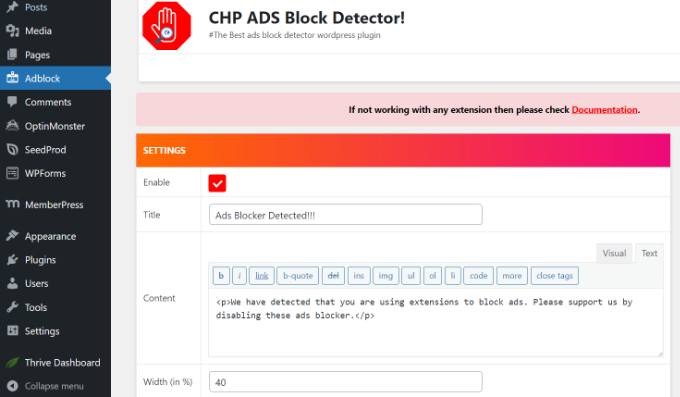
How to Detect AdBlock Users in WordPress
| Sr# | Headings and Subheadings |
|---|---|
| H1 | Introduction |
| H2 | Understanding AdBlock and Its Impact |
| H3 | Why Detecting AdBlock Users is Important |
| H3 | Benefits of Detecting AdBlock |
| H2 | How AdBlock Detection Works |
| H3 | JavaScript-Based Detection |
| H3 | Server-Side Detection Techniques |
| H2 | Implementing AdBlock Detection on WordPress |
| H3 | Using Plugins for Detection |
| H3 | Custom Code Implementation |
| H2 | Best Practices for AdBlock Detection |
| H3 | Providing Value to AdBlock Users |
| H3 | Optimizing User Experience |
| H2 | Handling AdBlock Users |
| H3 | Educating Users |
| H3 | Encouraging Whitelisting |
| H2 | Monitoring and Analyzing AdBlock Impact |
| H3 | Tracking Detection Success Rates |
| H3 | Analyzing User Behavior |
| H2 | Conclusion |
Introduction
In today’s digital landscape, online advertising plays a crucial role in sustaining many websites. However, the rise of AdBlock software poses challenges for publishers. This article delves into effective strategies for detecting AdBlock users on WordPress websites.
Understanding AdBlock and Its Impact
AdBlockers are browser extensions that prevent ads from displaying on web pages. Their widespread adoption has significant implications for content creators and advertisers alike.
Why Detecting AdBlock Users is Important
Detecting AdBlock users allows website owners to address revenue challenges caused by ad blocking. By identifying these users, targeted strategies can be implemented to improve monetization.
Benefits of Detecting AdBlock
- Enhanced revenue opportunities
- Improved user experience for non-AdBlock users
- Greater transparency in advertising metrics

How AdBlock Detection Works
There are two primary methods of detecting AdBlock usage: JavaScript-based detection and server-side techniques.
JavaScript-Based Detection
This method involves using JavaScript code to check if AdBlock is active in the user’s browser. While effective, it may be bypassed by advanced users.
Server-Side Detection Techniques
Server-side techniques involve analyzing HTTP requests to identify patterns indicative of AdBlock usage. These methods offer more robust detection but require technical expertise.
Implementing AdBlock Detection on WordPress
WordPress users can leverage plugins or custom code to implement AdBlock detection seamlessly.
Using Plugins for Detection
Plugins like “AdBlock Notify Lite” simplify the process of detecting AdBlock users. They offer customizable notifications to prompt users to whitelist the site.
Custom Code Implementation
For advanced users, custom code can be integrated into WordPress themes to achieve precise AdBlock detection and notification functionalities.
Best Practices for AdBlock Detection
Successful AdBlock detection strategies focus on delivering value to users while encouraging fair ad revenue.
Providing Value to AdBlock Users
Educational content, exclusive features, or ad-lite experiences can incentivize AdBlock users to support the site through whitelisting.
Optimizing User Experience
Notifications for AdBlock users should be unobtrusive and informative, highlighting the importance of advertising in sustaining free content.
Handling AdBlock Users
Effective communication and engagement strategies are key to addressing AdBlock users.
Educating Users
Transparent communication about the impact of ad blocking on content creators can foster understanding among users.
Encouraging Whitelisting
Encouraging users to whitelist the site or consider alternative support options can help mitigate the effects of AdBlock.
Monitoring and Analyzing AdBlock Impact
Continuous monitoring and analysis of AdBlock usage provide valuable insights for optimizing strategies.
Tracking Detection Success Rates
Regularly assessing the effectiveness of AdBlock detection methods helps refine detection techniques.
Analyzing User Behavior
Understanding how AdBlock impacts user behavior, such as engagement and conversion rates, informs strategic decision-making.
Conclusion
Detecting AdBlock users on WordPress is a proactive approach to navigating the challenges posed by ad blockers. By implementing effective detection strategies and fostering user engagement, website owners can sustainably monetize their content while delivering value to users.
FAQs
- Can AdBlock detection be bypassed? AdBlock detection methods can be bypassed by advanced users, but effective strategies can still capture a significant portion of AdBlock users.
- Are there legal considerations for AdBlock detection? AdBlock detection strategies should comply with privacy regulations and user consent requirements.
- How can I encourage users to whitelist my site? Providing compelling reasons, such as exclusive content or ad-free experiences, can encourage users to whitelist your site.
- What metrics should I track to measure AdBlock impact? Metrics such as detection success rates, user engagement, and revenue from whitelisted users are crucial for assessing AdBlock impact.
- Are there alternative monetization strategies for AdBlock users? Exploring subscription models, sponsored content, or affiliate marketing can diversify revenue streams beyond traditional advertising.
- How often should I update my AdBlock detection strategies? Regular updates and optimization of AdBlock detection strategies are recommended to adapt to evolving user behaviors and technology.






